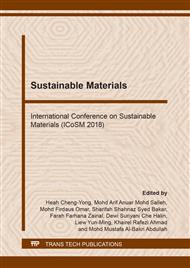p.422
p.433
p.440
p.451
p.462
p.469
p.476
p.481
p.487
The Effect of Different Sand Gradation with Ultra High Performance Concrete (UHPC)
Abstract:
Advances in concrete material research has introduced to development the new class of concrete which is known as Ultra High Performance Concrete (UHPC). Due to the most exceedingly awful on nature coarse aggregate quality, UHPC was delivered to success in concrete. This study investigated the effect of differentsand gradation (63-300μm, 300-600μm, 600-1180μm, and normal sand) on compressive strength and ultrasonic pulse velocity (UPV) of UHPC. The rheology of UHPC mixtures was determined by flow test conducted according to ASTM C1611 and the compression testwas performed to measure concrete compression strength at 7 and 28 days according to BS 1881-116 (1983). To determine the quality of concrete, UPV test were conducted according to BS 1881 part 201 (1986).From the experimental results, the results indicated that sand grading with 600-1180μm obtained the highest in compressive strength and UPV.The compressive strength at 28 days achieved 100 MPawith direct transmission of UPV 4.5% higher than semi direct.
Info:
Periodical:
Pages:
476-480
Citation:
Online since:
August 2018
Price:
Сopyright:
© 2018 Trans Tech Publications Ltd. All Rights Reserved
Share:
Citation:


